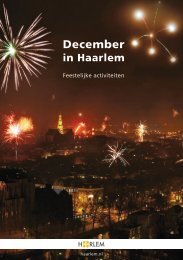SRON_Spectrum_2016
You also want an ePaper? Increase the reach of your titles
YUMPU automatically turns print PDFs into web optimized ePapers that Google loves.
can only take a glimpse inside through the<br />
window: everything is still there as if he could<br />
return at any moment, including the halfbutchered<br />
animals. Really weird...<br />
The good news today is that we have just<br />
managed to get the entire signal chain of the<br />
4.7 THz receiver to work. A local signal enters,<br />
we see the sky and a desired signal emerges<br />
for the detector. Some optimization still needs<br />
to take place, but all of the stages work.<br />
The bad news is that the toilet is not working.<br />
cables are currently still exposed with a big<br />
risk of picking up undesirable signals. The<br />
biggest problem is ESD, ElectroStatic Dis -<br />
charge. Due to the desert environment and<br />
the low temperatures the air is extremely dry.<br />
Every movement that you make results in the<br />
build up of static electricity especially if you<br />
are wearing a fleece jumper. As soon as you<br />
touch something made of metal it sparks.<br />
These discharges are fatal for our instrument.<br />
Once everything has been incorporated there<br />
will be a reasonable degree of protection but<br />
that is not the case yet. We are all doing our<br />
reminds me of a story I read long ago about<br />
wildebeests if I remember correctly, (Google<br />
does not work). To determine which direction<br />
the herd should take, one of the animals occasionally<br />
stands up with its head in a certain<br />
direction, and then it goes and lies down<br />
again. If enough animals have looked in the<br />
same direction then the entire herd goes that<br />
way.<br />
Very indirectly, problems here are tackled in<br />
the same manner. Somebody says something,<br />
nobody appears to listen, somebody says<br />
25<br />
<strong>SRON</strong> <strong>Spectrum</strong><br />
From now on it is the long drop: the Antarctic<br />
version of a privy, including snow swirling<br />
around and -10˚ C in the toilet.<br />
2 December 2015, Antarctica:<br />
best: we wear wrist straps to discharge static<br />
electricity, avoid artificial clothing, touch metal<br />
before we get near the instrument but a mistake<br />
can easily be made of course.<br />
something else. A solution is repeated by a<br />
third and a fourth, and suddenly we have<br />
chosen that direction. Fascinating. It works,<br />
but back in the Netherlands we do things very<br />
differently.<br />
the tension is mounting...<br />
The toilet has been repaired and that is a relief.<br />
The short drop is better in the long term.<br />
However our instrument is still not working<br />
well enough and that is less good news. The<br />
tensions are rising. Ideally you want to get<br />
this integration phase over and done with as<br />
quickly as possible. Many components and<br />
Seeing penguins is apparently<br />
a spiritual experience<br />
that changes you mentally<br />
In a nutshell, the instrument must be closed<br />
quickly and it must also function properly. But<br />
what is the right way forward? And when is it<br />
good enough? The decision-making process<br />
And then suddenly several large steps follow:<br />
the cryostat must be integrated with the telescope<br />
gondola. This interferes with our own<br />
work. The most vulnerable part, the local oscillator<br />
located on the outside, is taken off<br />
again. The calibration will therefore have to<br />
be repeated and the mounting plate that now






